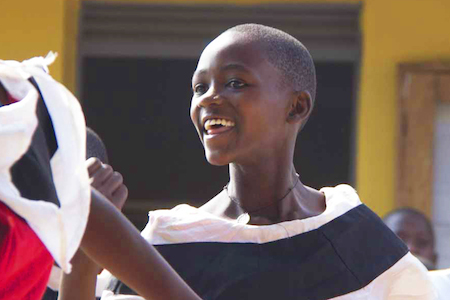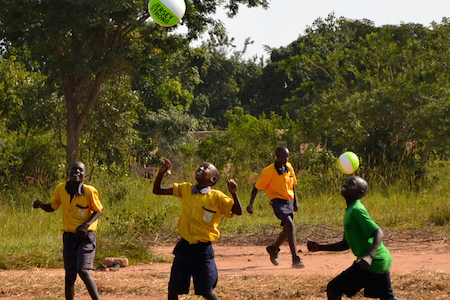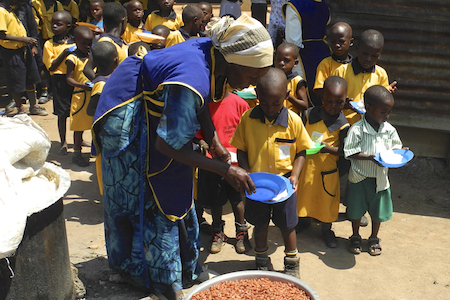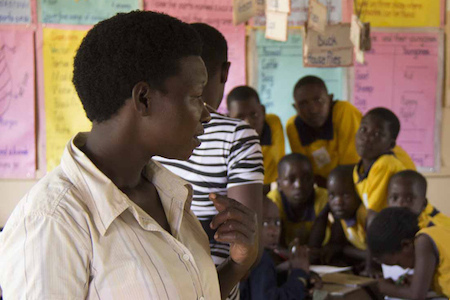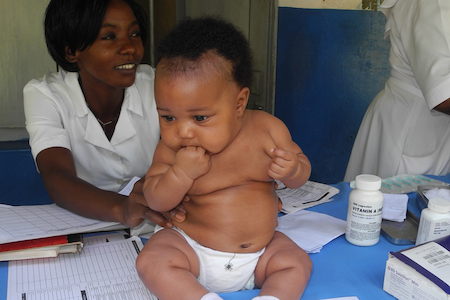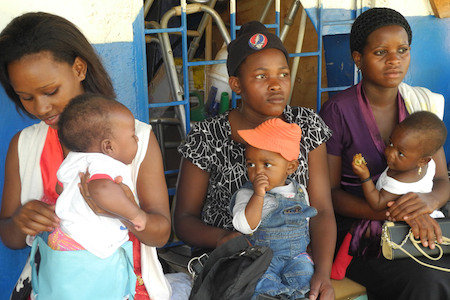How and when did ChangeALife Uganda start?
In August of 2006, Jean Semler and David Thelen traveled to central Uganda. Meeting the Ugandan parents, children, teachers, women’s groups, as well as seeing the schools and health centers, was a life-changing experience. The couple committed themselves to improving the lives of these children and their families in the villages of Nabbingo and Migyera. In March 2007, ChangeALife Uganda became incorporated as a NJ non-profit corporation and in April 2008, received its 501c3 designation. As of 2018, our implementing partner in Uganda is GTI – Grassroots Transformation Initiative Uganda, a NGO (Non-Government Organization).
Are ChangeALife Uganda and GTI non denominational?
ChangeALife Uganda is a non-denominational public charity in the US. GTI in Uganda is also non denomination non government organization. The St. Lawrence School is a Universal Public Education government supported school and children of any religion can and do attend. The health centers service all, regardless of religion. Micro-enterprise programs are also available regardless of religious affiliation.
Where in Uganda does ChangeALife Uganda work?
ChangeALife Uganda helps disadvantaged and orphaned children and their families in Migyera and Nabbingo, Uganda. Migyera is located 86 miles northwest of Kampala in the semi-arid Nakasongola District. Nabbingo is situated 9 miles from Kampala in a semi-urban area.
Who is Fr. Lawrence Kizito Kimbowa?
Fr. Lawrence Kizito Kimbowa was the inspiration behind ChangeALife Uganda. However, he is not active with the organization.
At what age does a Ugandan child start school?
Informal education begins with “Baby Class” as early as three and focuses on socialization. Formal education starts at age six. Some children begin late because of illness, death of one or both parents or because they live in a remote area without schools. Because many children are needed to work at home or on the family farm, school attendance is delayed or not an option, especially in a rural area like Migyera.
Does the Ugandan government contribute to education?
In 1997, the government declared it would provide free education. It provides very limited funds for buildings, equipment, teacher and administrator salaries, and maintenance.
What are Universal Public Education Schools like?
Public school buildings are mainly built of bricks with dirt or concrete floors, corrugated iron roofs and no electricity. Children typically sit on benches at a long table. Books are absent. The quality of education provided to Ugandan students attending government schools is questionable, parents send their children to private schools to receive a quality education if they can afford it.
What is the public education system in Uganda?
Uganda’s 7-4-2 education system was established while Uganda was a British Colony. The system was later adopted in 1962 when Uganda became an independent nation. The 7-4-2 system establishes 7 years of Primary School, 4 years of lower Secondary School and 2 years of upper Secondary School. Uganda started their free universal primary education (UPE) policy in 1997. Since then primary school tuition has been free in government schools. In 2007, Uganda government started the free universal secondary education (USE) policy, which was the first in all Sub-Saharan nations. Parents prefer private schools if they can afford it.
What is the Ugandan school calendar?
There are 3 school terms that begin in February and end in December. In the 3rd term, students must pass their exams in order to be promoted to the next grade. Term One: February to May; Term Two: May to August; Term Three: September to December
What follows 4 years of lower secondary school?
The students take “O” (Ordinary) Level National Examinations in 10 subjects at the end of Secondary 4. “O” level graduates must earn high scores for admission to “A” (Advanced) level Secondary Schools for a 2-year program in preparation for the university. Students study a maximum of 4 subjects and after completing Secondary 6, take the “A” level National Examination. The student score on this examination determines selection for University education, National Teachers’ Colleges or Government employment.
What is the class size in Ugandan public schools?
The government standard student to teacher ratio is 70 to one. The average class size in Migyera is 65 students. In 2016, the St. Lawrence school census listed 586 students.
Why is tuition needed for public education?
A 2005, survey commissioned for UNESCO’s Global Monitoring Report cited required fees for Public Education in 76 of 92 countries at the Primary School level. Education must be financed and alternative sources of funding for schools in Uganda are scarce. When fees are removed, education quality rapidly deteriorates. Fee-free education has proven to be of such low quality that it adds little value to a child’s future endeavors.
What do children wear to school?
It is the Ugandan National policy for all public school students to wear a uniform showing the name of the school. Boys wear a shirt and shorts and girls wear dresses. The students wear uniforms which consist of shirts and shorts for sports.
What subjects do children study in primary school?
Children study English, Math, Social Studies, Science, Reading, Writing, Luganda, and Religious Education. In addition they study music, art and agriculture.
What is a typical day like for a child from Migyera?
This description of a Ugandan child’s day is typical of the lives of the children who attend St. Lawrence Primary School. CALU believes that a child, if educated, can become catalysts for change – improving the quality of life in their families and communities. However, because many Ugandan children live in extreme poverty, simply going to school is a dream that remains out of reach for most of them.
The lives of Ugandan children aren’t like those of children in developed countries. There’s little in their lives but work. Every day is much the same – work all day in different ways, work in the evening and then go to bed late. It would be good if the day started with breakfast, but often it doesn’t. Except at St. Lawrence School, most children don’t have lunch either. Supper is after chores, late at night and before bedtime.
A typical day for a rural primary school child in Migyera, Uganda:
- 05:00 am Wake up, wash utensils and clean compound
- 05:30 am Collect water from the well or bore hole – may be half a mile or more away
- 06:00 am Wash legs and wear uniform. Most children don’t have breakfast. If they do, it is dry tea without sugar and any left over food.
- 06:15 am Begin walking to school (some set off earlier as some children have a 5km walk; there are penalties for arriving late)
- 07:00 am Arrive at school
- 07:15 am School assembly and prayers
- 07:30 am Go to class for lessons
- 10:30 am Break Time
- 11:00 am Lessons
- 01:00 pm Lunch break. Most children don’t have lunch but CALU provides posh and beans for all students
- 02:00 pm Back to class for lessons
- 03:00 pm Classes end, start work in school garden, clean classrooms, compound and latrines
- 05:00 pm School ends. Clean compound and classrooms
- 05:20 pm Walk home
- 06:30 pm Reach home, take off uniform & change into work clothes
- 06:00 pm Collect water, firewood, dig fields
- 07:30 pm Back home. Clean up and start homework
- 09:00 pm Have supper
- 10:00 pm Finish homework by candlelight
- 10:15 pm Bedtime
What subjects do children study in secondary school?
The curriculum includes English, Mathematics, Physics, Chemistry, Biology, French, History, Geography, Religious Education, Political Education, Literature, Commerce, Luganda, Computer Studies Music and Fine Arts. Home Economics, Agriculture, Wood and Metal Fabrication, and other practical subjects are taught to meet the demands of the labor market. Extracurricular activities include sports, games, plays and concerts.
How do classes in Uganda match to classes in the US?
In Uganda, there is primary school, secondary school and university. The grid shows the approximate match to the US school system, from an age perspective:
| Uganda | US grade | Age of child |
| Primary 1 | Grade 1 | 6 |
| Primary 2 | Grade 2 | 7 |
| Primary 3 | Grade 3 | 8 |
| Primary 4 | Grade 4 | 9 |
| Primary 5 | Grade 5 | 10 |
| Primary 6 | Grade 6 | 11 |
| Primary 7 | Grade 7 | 12 |
| Secondary 1 | Grade 8 | 13 |
| Secondary 2 | Grade 9 | 14 |
| Secondary 3 | Grade 10 | 15 |
| Secondary 4 | Grade 11 | 16 |
| Secondary 5 | Grade 12 | 17 |
| Secondary 6 | College | 18 |
| University | College | 19+ |
How do you read your Ugandan child’s report card?
Report cards for grades P1-P6 are called “Pupil’s Progressive Report.” Similar to the report cards for US children, report cards show mid year and final grades. (Look for the words ‘beginning/midterm’ and ‘terminal’ results.)
In grades P1-P3, children are graded in 9 subjects, for a total possible cumulative score of 900. There is no set cumulative score that is considered passing; similar to US schools, it is at the teacher’s discretion to promote to the next grade.
In grades P4-P6, children are graded in all subjects they take, with a maximum of 100 in each subject, as reflected on the report card. However, in terms of grades that ‘count’ towards a cumulative grade, there is only a maximum of 400, as only English, Math, Social Studies and Science are added for their total score. Again, there is no set cumulative score that is considered passing; similar to US schools, it is at the teacher’s discretion to promote to the next grade.
Once students finish P7 (our 7th grade), they must sit for a nationwide exam to determine if they will be allowed to move on to secondary school. The name of the exam is the Primary Leaving Exam (PLE). The exam covers the same 4 subjects tracked in later primary years: English, Math, Social Studies and Science. In this PLE exam, the regular number grade on the 0-100 scale gets translated into an alphanumeric grade.
Unlike our grading system where a D is close to failure, in Uganda D stands for “Distinction,” so a student with a D1 (85-100) or D2 (75-84) has earned the highest rating. Students receiving C3 (74-65), C4, C5, C6 (45-49) means high to low average performance with C standing for “Credit.” Lastly Pass 7 and then Failure (below 30). These ratings are then aggregated. The lower the aggregate number, the higher the grade score. If a child in Primary School gets a subject aggregate of 4 (a D1 in 4 subjects) up to 12, the child is 1st Grade/Division. An aggregate of 13 to 25 is 2nd Grade/Division 2, then 3rd Grade/Division 3, 4th Grade/Division 4 and Failure. Secondary School students have more subjects so a 1st grade is from 8-32 (8 means a student got D1s in 8 subjects.)
In the alphanumeric grading, the lower the number portion the better, according to the grid below:
| PLE Test Grade Range per subject | Division score translation |
| 85-100 | D1 |
| 75-84 | D2 |
| 69-74 | C3 |
| 60-68 | C4 |
| 55-59 | C5 |
| 50-54 | C6 |
| 45-49 | P7 |
| 40-44 | P8 |
| 0-39 | F9 |
The number portions of the alphanumeric Division grade get summed up. Boys must have a cumulative/aggregate score of 26 or below to be allowed to go into secondary school. Girls must have a cumulative/aggregate score of 28 or below to be allowed to go into secondary school.
DONATIONS
What do general donations support?
While donations for child sponsorship are the primary focus of ChangeALife Uganda, general donations fund prioritized projects, which directly improve the lives of sponsored children and their families. For example, the Functional Adult Literacy Program educates parents of our sponsored children on how to speak and write English and perform math calculations. English is the unifying language in Uganda. Literacy is essential in improving a household standard of living, the beneficiaries have become change agents in homes and communities. This is evidenced from the records they keep of their small businesses and follow up on their children’s performance.
Women’s Tailoring Project taught women how to make and repair clothes and enabled them to purchase a sewing machine through our micro-enterprise program. Other women are involved in making baskets, handbags and jewelry, which are sold in a craft shop in Migyera. Their increased income provides money for school fees and home improvements.
Donations to ChangeALife Uganda enabled teachers to advance their professional education leading to a bachelor’s degree. The Headmaster of St. Lawrence School completed his Masters in Education. Projects include computers for the school, over 500 reading books for the library, a new kitchen, electricity, and a generator, an instructional farm for the students, construction of a dormitory, new classrooms and teacher housing. In 2009, a major water project, QuartersForWater was initiated to provide clean water for the school, health center and 600 members of the community. It was completed in 2014 with the construction of a 512′ well and a 50,000L water tower. Construction has begun on a storied multipurpose building, In 2019 students will be eating their meals in the new dining hall.
What percentage of a general donation supports ChangeALife Uganda programs?
90% of all donations fund resources for our students, teachers, the school and ChangeALife Uganda programs.
HEALTHCARE
What is ChangeALife Uganda’s Healthcare program?
The goal for CALU’s health care initiative is to provide primary care health services to the sponsored children and their families in Migyera, in order to support educational goals, improve chances of children finishing school, and help families support themselves financially.
The St. Francis Health Center, a Level III clinic, opened July 4, 2012. Services include screenings and treatment for malaria, TB and other common respiratory conditions, treatment for diarrhea, typhoid, arthritis etc. and in 2017, minor surgery. CALU is also focusing on reducing maternal and infant mortality by encouraging more women to deliver in the clinic with appropriate medical care, thus reducing the transmission of HIV from mother to child during birth. As a result of a partnership arrangement with MildMay Uganda starting in August 2012, the clinic in Migyera provides services for the diagnosis and treatment of HIV. Maternity services were expanded a 2018 to provide C-Sections for women in the community.
2018 saw the development of a health records system to aid in measuring the impact of our medical interventions, the expansion and support of maternity services and Village Health Teams for community outreach and education, as well as providing ongoing Continuing Medical Education opportunities for clinic staff.
INCOME GENERATING
What is ChangeALife Uganda’s Functional Adult Literacy Program?
The ability to read, write and count are important factors that increase the success of an income generating program. Our Functional Adult Literacy [FAL] project enables vulnerable groups of women and children to improve their standard of living and address issues of poverty, abuse and exploitation. By learning to read, write and count combined with other functional literacy themes, adult learners improve their ability to increase house hold income. For example, a person who desires to start up a poultry project is afraid because they cannot take records because they are unable to read and write.
This project was launched in January 2013 as a pilot project in Nabbingo in the Wakiso District of Uganda and in Migyera in the Nakasongola District. It expanded to 5 villages in 2014 and 2015, 6 villages in 2016, 7 villages in 2017 and now 9 villages in 2018.
The participants have become change agents in their homes and communities, evidenced from record keeping of their small businesses and follow up on their children’s performance at school. The program also acts as a strong foundation for resolving gender inequalities, increasing people’s entrepreneurship, enabling the poor to participate actively and effectively in efforts for achieving their livelihood development. The project is making a difference in our beneficiary’s families.
What is ChangeALife Uganda’s Microenterprise program? This program is being revised in 2019
ChangeALife Uganda works to empower families in Nabbingo and in the poor rural community of Migyera by helping them develop marketable skills to further their financial independence. The program targets the women and families of our sponsored children providing loans to socially and economically disadvantaged households, and women owned small businesses to start build and/or grow businesses.
It consists of four components: Microloans/Individual Loans, Group and Business Loan Advantage, Crafts and Tailoring and Children’s Enterprise Program
Microloans/Individual Loans: These loans are designed for underserved individuals, families and households.
Group and Business Loan Advantage: These loans are to small groups and businesses that might not otherwise be able to obtain financing.
Crafts and Tailoring: The crafts and tailoring projects are designed to develop practical, marketable skills through the production baskets, handbags, trays and jewelry and clothing.
Children’s Enterprise: The Children’s Enterprise program provides loans to children to raise an animal of their choice: chickens, rabbits, goats or pigs. The loan is paid back when the off spring are sold. Bank accounts have been opened for each child for the additional income raised from the sale of other offspring. Money received from the products sales goes back to our women and the school.
SPONSORSHIP: DollarsForScholars
How are the sponsored children identified?
Parents, teachers, social workers and Fr. Lawrence identify children with the highest potential for academic success coupled with demonstrated leadership skills and the most need.
What benefits do sponsored children receive?
We focus on the health and wellbeing of the whole child and help children of various ages who need sponsors. Each of our sponsored students receives tuition, a uniform, school supplies, daily nutrition, a mosquito net, counseling and health services to support successful learning. We offer boarding for primary school children who are orphaned, unable to live and study at home and when students enter primary six. We also provide boarding for secondary school and post secondary students.
How do I become a sponsor?
Becoming a sponsor is a significant commitment and we hope you will be that child’s sponsor through the university or technical school.
Download and complete the ChangeALife Uganda sponsorship application form by clicking here. Mail it to:
ChangeALife Uganda, 134 Rocktown Lambertville Rd. Lambertville, NJ 08530 or email to jsemler@changealifeuganda.org. We will follow up with you about selecting a student.
What is the cost of sponsorship? What are the annual fees?
As students progress in their education, the cost of tuition increases. A sponsor may wish to fund their student’s increased cost. However, some sponsors are not able to increase their contributions; therefore, student’s fees can be funded through co-sponsorships, group sponsorships or donations. Annual renewal letters are mailed in March.
Primary School:
Tuition: $360 for three terms or $30/month for 12 months
Boarding: $300 for three terms or $25/month for 12 months
Combined Tuition & Boarding: $660 for three terms or $55/month for 12 months
Secondary School:
Tuition: $600 for three terms or $50/month for 12 months
Boarding: $300 for three terms or $25/month for 12 months
Combined Tuition & Boarding: $900 for three terms or $75/month for 12 months
Post Secondary / University:
Tuition: $1,200 for year for fees and boarding or $100/month for 12 months
Becoming a sponsor is easy. Follow the steps below and you can change the life of a Ugandan child!
Why is boarding important?
Some children need to board at school to succeed because of the distance they live from school or because their home situation is challenging. However, the primary reason for boarding is academic. In addition to the benefits of a bed, clean water and nutritious food, a student who boards benefits from the required “study time” before class and in the evening to enable them to meet the demands of the challenging curriculum.
What is the difference between sponsoring children in Migyera and Nabbingo?
In Migyera, the children attend the St. Lawrence Primary School. Sponsorship donations pay the sponsored child’s tuition and fees, nutrition, uniforms, exercise books, schools supplies, medical care, sanitation and home care. All children, regardless of sponsorship, who attend the school benefit from lunch, exercise books, teaching supplies, better teachers and a demonstration garden to learn farming skills. Migyera children who graduate from St. Lawrence School Primary School will go on to attend secondary school.
Children from Nabbingo and surrounding areas attend various primary and secondary day or boarding schools that offer a higher quality education compared to overcrowded Universal Public Education schools. During school holidays, the children are able to build friendships with other sponsored children and learn farming skills. Sponsorships for these children support all or part of their tuition and school fees.
What do I write to the child I am sponsoring?
ChangeALife Uganda encourages sponsors to write to their child and encourage them to focus on their studies. Although Ugandan children speak the local language, Swahili, at home, they learn to speak and write English, the official language of Uganda, in school (Swahili was designated in 2005 by the Ugandan Parliament as the country’s second official language). It is a special experience for the child to receive a personal communication from their sponsor and they cherish the letters and photos that are sent.
How do I send a letters or gifts to a child I sponsor?
Sponsors who wish to send a letter can do so by either regular mail or email.
Send mail and / or packages to:
Name of Child
GTI Grassroots Transformation Initiative Uganda
P.O. Box 70430
Kampala
Uganda
If you prefer email, send your letter to jsemler@changealifeuganda.org with child’s name, number in the subject line. It will be forwarded to Uganda, printed and given to the child.
Gift Ideas:
Keep in mind that postage is very expensive. Mail takes 2 – 3 weeks to arrive at the post office or a donation waits until the next time funds are wired. When our staff is notified, the gift is picked up and all items in the box are recorded before delivering it to the child. If the child is on holiday from school, it may take longer.
- School supplies: pencils, sharpeners, pens, crayons, scissors, rulers, and calculators
- Atlas, dictionary, word building books, reading and activity books, stickers, photographs
- Sports equipment (soccer balls, Frisbee, jump rope, net ball for girls)
- Clothes (climate: lows in 60s & highs in lower 80s); girls: no shorts
- Postcards or maps from your state
- Scrabble board game
- Give an animal: A gift of a chicken, rabbit, goat, or pig whose offspring, when sold, can provide nutrition and income for the child and their education. See children’s microenterprise program.
Please do not send money in the mail. If you wish to give money as a gift perhaps for a pig, chicken or goat project, mail it to ChangeALife Uganda, 134 Rocktown Lambertville Rd. Lambertville, NJ 08530. It will be designated for your child when funds are wired.
Will the child I sponsor write back?
Letter writing is an educational experience. Teachers help the children to express their thoughts and feelings and provide guidance if needed. The children write twice a year.
The children and their families are incredibly grateful for additional gifts or donations they receive and will send a thank you letter. Because processing a donation or delivering a gift may take a while, it can be a number of months until you receive a thank you. A photo of the child with your gift is taken, a thank you letter is written and emailed or mailed to the US and then to you.
What information does a sponsor receive from ChangeALife Uganda?
Sponsors receive a donation receipt, your child’s profile and photo and guidelines about letter exchange and sending gifts. A bi-monthly newsletter with updates on sponsorship, current events Ugandan culture and all issues related to the successful sponsorship of a child is e-mailed. Once a year you will receive the child’s report card and updated photo.
Do sponsored children ever leave the program?
At times a sponsored child’s circumstances may change. For example, families may move and a child will be forced to leave the Sponsorship Program or they don’t maintain the grades or don’t take this opportunity for education seriously. We will inform the sponsor if this occurs and will offer the opportunity to support another child in need.
Does each child have only one sponsor?
Most children have one sponsor. Some are sponsored by a group of friends or colleagues who collectively fund one child’s education. When the child enters secondary school, the cost of education increases. We offer the sponsor the opportunity to support the child’s secondary and university education or co-share.
How long should my sponsorship last?
ChangeALife Uganda offers the opportunity to sponsor a child until the completion of their education. Our hope is that students continue on to Vocational School or the University. However, because circumstances can change, sponsorships may be discontinued at any time.







